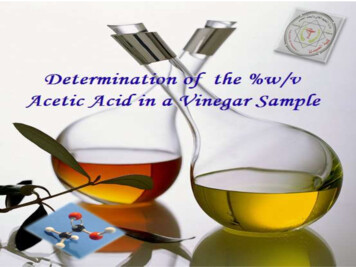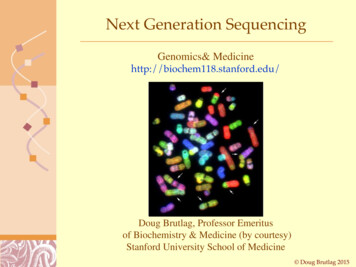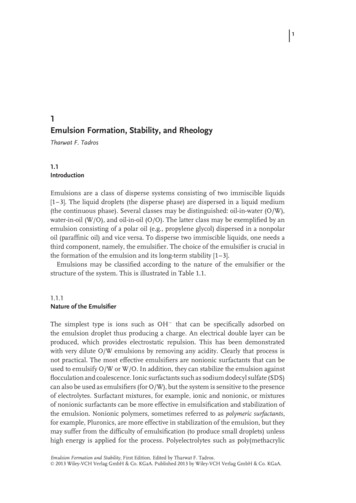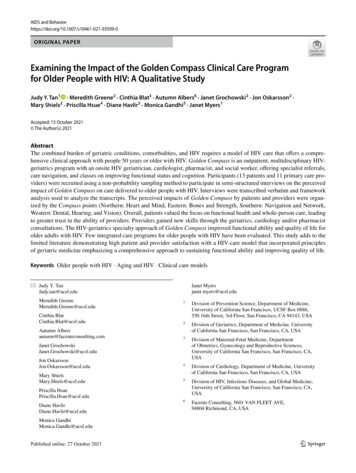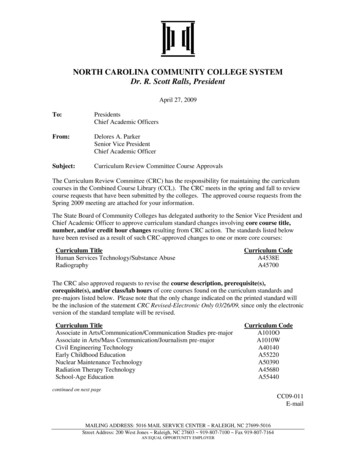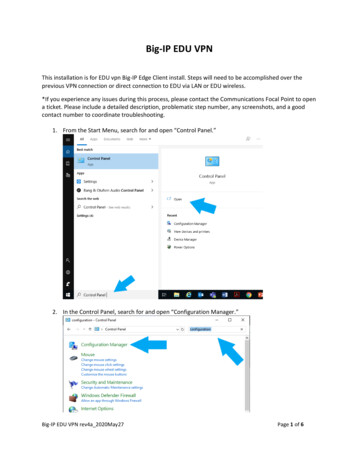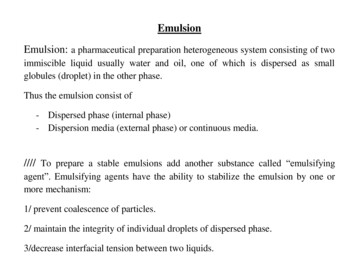
Transcription
EmulsionEmulsion: a pharmaceutical preparation heterogeneous system consisting of twoimmiscible liquid usually water and oil, one of which is dispersed as smallglobules (droplet) in the other phase.Thus the emulsion consist of- Dispersed phase (internal phase)- Dispersion media (external phase) or continuous media.//// To prepare a stable emulsions add another substance called “emulsifyingagent”. Emulsifying agents have the ability to stabilize the emulsion by one ormore mechanism:1/ prevent coalescence of particles.2/ maintain the integrity of individual droplets of dispersed phase.3/decrease interfacial tension between two liquids.
Types of emulsions:1. Oil in water emulsion (O/W): The oil droplets are dispersed throughout theaqueous phase.2. Water in oil emulsion (W/O): The water is dispersed throughout the oil phase.The type of emulsion is determined by factors:1. The ratio of the two immiscible phases.2. The type of emulsifying agent used and its concentration. (Example acaciaalways give O/W emulsion)3. The order of mixing of the two immiscible phases.5.Presence of additive.
Tests for identification of emulsion type1. Miscibility test: An emulsion will mix with a liquid that is miscible with itsexternal phase. Therefore, O/W emulsion is miscible with water while W/Oemulsion is miscible with oils.2. Conductivity measurement: Systems with aqueous external phases willreadily conduct electricity, whilst systems with oily external phases will not.3. Staining test: Water-soluble and oil-soluble dyes are used. They will mix andstain the external phase of the emulsion.
Why emulsions?1. To enhance the palatability of oils and oil-soluble drugs.2. To solve the issue of insolubility. i.e. when we have two liquids that areimmiscible, we cannot form solution but emulsion3. Emulsion can increase the absorption of oils and oil-soluble drugs throughintestinal walls.4. TPN (total parenteral nutrition) is feeding a person intravenously, bypassing theusual process of eating and digestion. The person receives nutritional formulaethat contain nutrients such as glucose, amino acids, lipids and added vitaminsand dietary minerals usually in a form of emulsion. Uses of emulsions:1. Emulsions for internal use: Oral emulsions are stabilised O/W dispersions thatmay contain one or more active ingredient.2. Emulsions for intravenous administration must also be of the O/W type.However, intramuscular injections can also be formulated as W/O products.3. Emulsions for external use: Semisolid emulsions are termed creams and morefluid preparations are either lotions or liniments (liniments are intended formassage). Both W/O and O/W are available for external use.
Method of preparation of emulsion:-Dry gum method-Wet gum method-Nascent soap method or (Bottle method)-Electrical method There are two main steps in the preparation of emulsion (dry and wet)1) Preparation of primary emulsion which is thick, creamy and stableemulsion. Its consist of ( oil, acacia, and water for primary emulsion).2)Addition of other substances (Dilution):t of acacia (water acacia 2).calculated separately and the sum of the quantities is used.
1. Dry gum method1. Triturate the oil with acacia powder in a dry mortar.2. Measure water for the primary emulsion and immediately add all of it to themortar with vigorous trituration in one direction until the mixture becomesthicker and the primary emulsion is formed. The primary emulsion ischaracterised by crackling (or clicking) sound.3. Calculate the remaining vehicle: Final volume – (liquid ingredients).4. Divide the remaining vehicle into 3 parts: 1st part for dilution of the primaryemulsion, 2nd part for washing the mortar and pestle, and the 3rd part forcompleting the emulsion to its final volume.
2. Wet gum method1. Here, the order of mixing is different: Water is added to acacia with quicktrituration to form mucilage.2. Oil is measured with a dry measuring cylinder and added to the mucilage insmall portions (gradually). Continuous trituration in one direction is requiredafter each addition until a thick primary emulsion is obtained.3. Other steps are the same as continental method.
Which method?2. If
Notes:flavouring agents are usually dissolved in the dilution part of the emulsion.centre of the primary emulsion with continuous trituration.-insoluble substances: are added to the primary emulsionemulsifying agent are added as near last as is practical. For example, alcoholhas a precipitating action on acacia and therefore alcohol or alcohol-containingsolutions are should not be added to the primary emulsion.formation of primary emulsion because it will react with FFAthat present in theoil and form soap of w/o type that cause inversion and break emulsion , thusthese substances should added after the formation of primary emulsion becauseacacia coat the droplet of emulsion.
1Oil of turpentineP.W.qs.Ȝ ii (volatile oil) iCalculation of 10 E.1. Oil Ȝ ii 8 ml2. acacia ½ the oil 4 g3. Water 2 acacia 8 ml4. 8 ml of water and 4 g of acacia will be used to form the primary emulsion.5. Approximate volume of the remaining vehicle (water) 30 – (8 8) 14 ml.6. 14 3 4.66pestle, and 4.66 ml for completing the emulsion to its final volume.
Procedure1. Triturate 8 ml of turpentine oil with 4 g of acacia powder in a dry mortar.2. Measure 8 ml of water and add all of it at once to the mortar with immediatevigorous trituration in one direction until the mixture becomes thicker and theprimary emulsion is formed.3. Add 4.66 ml of water gradually to the mortar with mixing to dilute the primaryemulsion.7. Transfer to a measuring cylinder and wash the mortar with 4.66 ml of water.Add this part to the cylinder.8. Complete the volume to 30 ml with the last 4.66 ml of water.9. Transfer to a suitable container and label.externally as rubefacient and muscle relaxant.
2Ȝ iiCastor oilP.W.qs.(fixed oil) i (vehicle)Calculation of 10 E.1. OilȜ ii 8 ml2. acacia ¼ the oil 2 g3. Water 2 acacia 4 ml4. 4 ml of water and 2 g of acacia will be used to form the primary emulsion.5. Approximate volume of the remaining vehicle (water) 30 – (8 4) 18 ml.6ml for completing the emulsion to its final volume.1. Weigh 2 g of acacia and place it in the mortar.2. Measure 4 ml of water and add it to the mortar with trituration to formmucilage.3. Measure 8 ml of castor oil and add it gradually (part by part) to the mucilage inthe mortar with continuous trituration in one direction until the mixturebecomes thicker and the primary emulsion is formed.4. Dilute the primary emulsion with 6 ml of water with continuous trituration.5. Transfer to a measuring cylinder and wash the mortar with 6 ml of water. Addthis part to the cylinder.6. Complete the volume to 30 ml with the last 6 ml of water.7. Transfer to a suitable container and label.
3Olive oilȜ ii (fixed oil)Ferric ammonium citrategr X (Trivalent electrolyte)P.W.qs. i (vehicle)(soluble) is dissolved in the dilution part.
4Castor oilȜ ii (fixed oil)Bismuth carbonategr X (water-insoluble solid –divalent)P.W. i (vehicle)qs.or spread overthe surface of the primary emulsion.ulcer.
5Ȝ iss (volatile oil)TurbeneAlmond oilȜ IV (fixed oil)Tincture of toluȜ ii (precipitate forming liquid)Tincture of ipecacȜ ii (water miscible liquid)P.W.mitteqs. IV (vehicle) iCalculation of 10 E.Turbene 1.5x4x1/4 1.5mlAlmond 4x4x1/4 4mlAcacia (1.5x1/2) (4x1/4) 1.75gmWater 1.75x2 3.5mlMix oil Dry gum.30-(1.5 4 3.5 2 2) 17 ml
the primary emulsion with continuous trituration.luble and can be added with the dilution part.almond oil is nutritive. The tincture of tolu is expectorants. Tincture of ipecacin low dose used as expectorant and in large dose as emitting agent.
3. Nasceut soap methodsoap act as emulsifying agents and some are prepared bymixing the oily phase containing a fatty acid such as oliveoil and an equal volume of aqueous phase containing thealkali such as Ca(OH)2 or NaOH solution placed in widemouth bottle with agitation of mixture FFA of the oilreact with alkali to form soap which act as E.A this soapforms at time of mixing (so called nascent soap) or in situsoap. The preparation of emulsion in this method used forexternal use and does not require the preparation ofprimary emulsion.
The method may be used to prepare either O/W orW/O depending on whether monovalent orpolyvalent hydroxide employed.Ca soap w/o E divalentNa soap o/w E monovalentNote: Soap are an ionic E.A they may produceirritant and laxative action in intestinal tractconsequently they are not used in orallyadministration.
Castor oil10mlOleic acid5mlCalcium hydroxide solution Q.S 30 mlFt. EmulsionSig: as directed
Procedure:1) Take clear dry bottle2) Mix castor oil (FFA) 10ml oleic acid (FFA) 5ml, shake them wellfor about 1 min (volum 15ml).3) Add to them 15ml of Ca(OH)2 sol. from supernatant.4) Shake vigorously for about 1min to obtain W/O emulsion.FFA alkali Soap( E.M)w/oCa(OH)2 divalent alkali so calcium oleate soap is produce so w/oemulsion.Lime water is Ca(OH)2This Rx is used externally as emollient.
Liquid paraffin emulsionLiquid paraffin10mloleic acid5mlSodium Hydroxide solution Q.S30ml.Sig. as directed
Liniments:They are liquid or semiliquid preparation of analcoholic or oily preparation, they are used andapplied externally with message and friction. Itmay contain substances processing analgesic,rubifacient, soothing and stimulant properties, itshould not applied to broken skin, it makevasodilation to relief muscle spasm.
White liniment (Emulsion type liniment)Ammonium chloride12.5gDilute ammonia solution45mlOleic acid83.3mlTurpentine oil250mlWater625mlFt. emulsionProcedure:1. Mix turpentine oil and oleic acid in clean dry wide mouth bottle.2. In another flask add equal vol. of warm H2O to dilute ammonia solutionand add this diluted solution step by step to oily liquid , shaking vigorously aftereach addition.3. Dissolve NH4CLin the rest of H2O and added to the bottle gradually with shaking.
In this liniment turpentine oil is emulsified withNH4 oleate produced from oleic acid and dilutedammonium solution, ammonium oleate is o/wemulsion (monovalent soap), but the preparationalso contain NH4cl which due to common ioneffect depress the ionization of the soap anddecrease the solubility in water, this together withhuge % of turpentine oil in the liniment causephase inversion, producing w/o emulsion.
Hydrophilic lipophilic balance (HLB):One of the desirable properties of an emulsifying agent is that itundergo strong adsorption at the interface between the hydrophilic(Water soluble) and the lipophilic (Oil soluble) tendencies of thesurfactant. If the E.A is predominantly hydrophilic, it tend to form ano/w emulsion. If its predominantly lipophilic, it favor to form an w/oemulsion. HLB Scale:HLB number usually between 1-20 represent the relative proportion ofthe lipophilic and hydrophilic parts of the molecule. High no. (818)indicates a hydrophilic molecule and produce o/w emulsion. Lowno. (3-6)indicates a lipophilic molecule and produce w/o emulsion.
Two or more surfactant can be combined to achieve a suitable HLBvalue and often give better results than one surfactant alone. The HLB method (special for non ionic E.A) e.g polysorbate(Tween) and sorbitan ester (span).The blend of emulsifiers contributes one or several actions:1/ it provides the proper hydrophilic-lipophilic nature.2/ it establishes a stable film at the interface.3/ it supplies the desired consistency.4/contributes certain other properties such as emolliency, spreading anddeflocculating.
Required HLBLiquid paraffin35g12Wool fat1g10Cetyl alcohol1g15Emulsifier5gWaterQ.S100gmthe total amount of oil phase35 1 1 37The proportion of each oil ingredients.Liquid paraffin 35/37 0.946Wool fat 1/37 0.027Cetyl alcohol 1/37 0.027
The total required HLB (RHLB)0.946 x 12 11.4Liquid paraffin0.027 x 10 0.3Wool fat0.027 x 15 0.4Cetyl alcoholSo totalRHLB12.1High value so o/w emulsion
Emulsifying agent blend (span 80 tween 80),HLB of span 4.3HLB of tween 15Assume that span 80 tween 80 1Let x amount of span 80 in mixtureThen 1-x amount of tween 804.3X 15 (1-X) 12.1 RHLBX 0.275 span 801-x 1-0.27 0.73g tween 80The total amount of mixed emulsifier in Rx is 5gmX 5 x 0.27 1.35g Span 801.35 (sp gr.0.88) 1.53ml5x 0.73 3.65g tween 803.65 (sp. gr.1.09) 3.35ml
Procedure:1. Mix the oil phase together (consist liquid Paraffin cetylalcohol wool fat span 80 it is lipophilic E.A) Warn toabout 700C in W.B2. Mix tween 80 with water(100-(35 1 1 5) 58 g water) inanother beaker, and heat to (2-30C) more the oily phase toprevent crystallization of waxes.3. Add water phase to oily phase gradually and mixing byelectrical stirrer Until get o/w em we get white coloremulsion no yellow color of oil which is disappeared due toemulsification by E.A. The type of em. is o/w (since it depend on HLB value)
SuppositoriesAre solid medications intended for insertion into bodycavities such as rectal and vaginal for local or systemicaction. They disintegrate in the body cavity either bymelting or by dissolutionIt contain : active ingredient & baseReasons for the Rx of Supp. :1- To exert a direct action on the rectum and on the vaginasuch as hemorrhoid, constipation, and infection.2- To promote evacuation of the bowl3- To provide a systemic effect
Systemic treatment by the rectal route is ofparticular value for :1) Treating patients who are unconscious , mentallydisturbed or unable to treat by oral medications becauseof vomiting or pathological condition of the GIT2) Administrating drugs such as (aminophylline) thatcause irritation , ibuprofen , Indomethacin & aspirinespecially if the patient has ulcer or GIT disturbance3) Treating Infants4) Drugs that are affected by the pH of the stomach or theintestine , so they are preferred to be used in Supp.dosage form
Properties of the Ideal Base1) It should melt at body temp. or dissolve or disperse in bodyfluids2) It should release any medication readily3) It should keep its shape when handled4) It should be non-toxic and non- irritant5) It should be stable on storage6) It should be compatible with any additives and medications7) It should stable if heated above its melting point8) It should be easily molded and do not adhere to the mold9) Solidify quickly after melting
Types of Supp. Base :1)Fatty Base these are melted at body temp. ex:Theobroma oil2)Water soluble or water miscible bases , eitherdissolve or disperse in rectal secretions ex:Glycerogelatin base and Macrogols (PEG) Method of preparation of the Supp. : By(Mold or Hand ) Mold Method is either by (Compression orFusion)
Fusion Method (Hot process)1)Melting a suitable Base2)Incorporate the prescribed amount of finelypowdered medicaments3)Pouring the mixture into the mold Compression method (Cold process)The drug incorporated with unmelted base and theresulting mass shaped either by hand orcompression in a metallic mold.
Supp. formulated in different shapes and sizes(usually 1-4 g) Mold calibration: the mold generally madeof metal in two halves which are clampedtogether by screw. The capacity of the mold isconfirmed by filling the mold with chosenbase. The total Wt. calculated and a mean Wt.obtained.
Water Soluble or water miscible bases1) Glycerol –Gelatin baseThis is a mixture of glycerol and water made into a stiff jellyby adding gelatin. Supp. and pessaries , the proportion beingadjusted to the purpose for which the preparation is intendedThe mass for glycerol-gelatin sup. (B.P): This contain about14% w/w gelatin and 70% w/w glycerol (for use in hot climateup to 18% w/w of gelatin may be included)Stiffer masses containing a higher proportion of gelatin arealso used when the product contain more than about 20% ofsemi liquid or liquid, because such addition makes the masstoo soft.
Glycero-gelatin base supp.are less often used than fatty base supp.Because of its disadvantages which are:1) They have physiological action (Glycerin sup. B.P is used aslaxative)2) They are more difficult to prepare and handle3) Their dissolution time depend on the content and the quality of thegelatin and the age of the base4) They are hygroscopic ( cause dehydration of the rectal mucosa andirritation )5) Gelatin is incompatible with protein precipitants agents such astannic acid6) Because of the water content, microbial contamination is morelikely than fatty base so preservatives may require to be added to theproduct
1) Macrogols PEG The characteristics that commend their use for this purpose are:1) The mixture generally has a melting point 42oC above the body temp.2) Because of this m.p they do not melt in the body but gradually dissolve anddisperse releasing their medication slowly and providing longer action thanfatty bases with no medical properties3) Their physical properties can be varied by suitable mixture of high and lowpolymers4) High polymers give hard product that dissolve and release their drugslowly5) Softer , less brittle preparations that disperse and liberate their drug morequickly are obtained by mixing high with either medium or low polymersby adding plasticizers6) They are not prone to microbial contamination
Their Disadvantage include :1) They are hygroscopic and have consequent disadvantages ofglycerol gelatin base2) It has good solvent properties that can result in retention ofthe drug in the liquefied base , with consequent reduction inthe therapeutic activity3) Product sometimes fracture on storage particularly if theycontain water4) Crystal growth of certain medications may occur5) They are incompatable with bismuth salts , tannic , phenol(may lose its antimicrobial activity) , iodine ,pot. Iodide andsorbitol6) They become brittle if cooled quickly also on the storage
PreparationsGlycerogelatin supp. B.PGlycerin70gGelatin14gPWqs.100 gMitt 5 supp.Ft supp. of 2 gm We do the calculation for 7 supp. Each with 2 gm 14 gm (total wt.)Glycerin 9.8 gm (in 14gm total wt.)Gelatin 1.96 gm (in 14gm total wt.)14 – (9.8 1.96) 2.24 approximately 3 ml of PW
Method of Preparation:Add the gelatin to about 3 ml of PW heated nearly to boiling ,then add the glycerin previously heated to 100C for 15 min oruntil dissolution is completed , adjust the wt of the product to14 gm by the addition of the hot p.w (if less) or by evaporation(if exceeded ), then pour into a suitable mold of 2 gm (which ispreviously lubricated with liquid paraffin) then cool it by icebath.Note: 1/avoid over heating because gelatin is protein soundergo denaturation2/avoid over stirring to prevent air bubble3/glycerogelatin sup. does not necessary to over fill the moldand this type of product does not require to be trimmed
Glycerin supp. (U.S.P)Glycerin91 gmSodium stearate9 gm (Solidifying agent)PW5 gmFt supp.Mitt 5 supp.We use a mold of 1 gm , calculation for 7 supp. , 7*1 7 gm (total Wt.)Glycerin 6.06 / sp.gr. 4.84 mlSod. Stearate 0.6 gmPW 0.34 gm of waterMethod of preparation:Put 4.84 ml of glycerin in a beaker, heat in water bath up to 120 C , add 0.6 gm of sod.Stearate to the glycerin with gentle stirring, then add 0.34 ml of PW with continuousheating until you get a suitable mixture (homogenous) , adjust the total weight to 7 gmthen pour it into a (1 gm) mold which is previously lubricated with liquid paraffin andcool it in ice bath
PEG 4000 33%PEG 6000 47%Water20%Ft supp. Of 2 gmMitt 5 supp.We do calculations for 7 supp. * each with 2 gm 14 gm final weightMethod of Preparation:Put PEG6000 in the beaker and melt it in water bath, then add PEG4000 and melt it with continuous stirringthen add water , mix well and pour the product to the mold which is previously lubricatedNote1: we add an excess of the product to the mold surface to compensate for the shrinkage in volume due tocooling by ice then after cooling we cut (with a sharp tool) the edge and get the supp.Note2: we always start with the higher molecular weight and then the lower molecular weight , knowing thatas the molecular wt. increase the melting point increase , the stability increase , the solubility decrease andthe release is decreased .Note3: PEG with molecular wt. 300,400,600 are clear colorless liquid , while with molecular wt. more than1000 it is wax like solid (increasing mol.wt. increases the hardness)Note4: PEG is synthetic protein so don’t undergo contamination and growth of M.O
PEG 400 4% sp.gr 1.12PEG 1000 96%Ft supp.Mitt 5 supp. using 1g moldPEG 4000 25%PEG 1000 75%Ft supp.Mitt 5 supp. using 2g mold
2/ Fatty BasesTheobroma oil (cocoa butter). It is a mixture of theglycerol esters of stearic , palmitic , oleic andother fatty acids.It has valuable characteristics:1) A melting point range of 30-36 ⁰C , it is solid at normal temp but itmelt in the body2) It is readily liquefies on warming and solidify on cooling rapidly.3) Miscibility with many ingredients4) Blindness therefore no irritation occurs.
The disadvantages:1) Polymorphism2) Adherence to the mold due to slightly shrinkage3) Melting point too low for hot climate4) Melting point reduced by soluble ingredients (add bees wax)5) Slow deterioration during storage(oxidation of unsaturatedglyceride) use witepsol instead.6) Poor water absorbing capacity7) Relatively high cost
#Polymorphism : the crystal arrangement has the samechemical properties but different in physical properties. Iftheobroma oil melted at not more than 36⁰C and slowly cooledit forms stable beta crystal with normal melting point but ifover heated it may produce on cooling unstable gammacrystal which melt about 15 ⁰C or alpha crystal which meltabout 20 ⁰C . These unstable form eventually return to thestable condition but this may take several days and thesuppository may not set at room temperature or if set bycooling may remelted in the warmth of patient home. Thislowering of M.P can also lead to sedimentation of thesuspended solid . The β is the most stable one , its meltingpoint is higher than α and , it is the only one to be used .Theα and has a much lower melting point than β so it cannot beused as a base , and if used and left for several days it willconvert to the β type .
Displacement ValueThe volume of the suppository from a particularmold is uniform but its weight will vary becausethe density of the medicaments usually differsfrom the density of the base.The DV of a drug is the number of grams of drugwhich displace one gram of the base
D.VBismuth subnitrate0.5 gm4Cocoa butter qs to fill 2 gm moldFt supp.Mitt 8 supp.CalculationsWe do calculations for 10 supp.0.5 * 10 5 gm wt of Bismuth subnitrateDisplacement value for Bismuth subnitrate is (4)Wt. of the base displaced by drug wt. of drug / DV 5/4 1.2 gm displaced Base10 supp. * 2 gm.(mold) 20 gm. weight of Base20 gm – 1.2 gm 18.8 gm of Base usedSo For 10 suppositories they will contain 18.8 gm. base and 5 gm of drug18.8 5 23.8 gm wt. of 10 supp.23.8 / 10 2.38 gm wt. of each supp.
D.VTannic acidOil of Theobromagr Vq.s to fill0.9gr XV moldFt Supp.Mitt 3 supp.Calculations:5 gr / 15 0.333 gm of tannic acid15 gr / 15 1 gm mold0.333 * 5 1.665 gm of drug1 gm * 5 5 gm of total BaseDV for tannic acid is (0.9) Wt of the base displaced by drug wt of drug / DV 1.67 / 0.9 1.855 gm of base displaced by tannic acid5 – 1.855 3.145 gm of the base usedSo For 5 suppositories they will contain 3.14 gm base and 1.67 gm of drug3.14 1.67 4.81 gm wt. of 5 supp.4.81 / 10 0.982 gm wt. of each supp.
D.VBismuth subgallate0.2 gm2.6Resorcinol0.06 gm1.3Zinc oxide0.13 gm4.8Oil of Theobromato fill2gm moldFit. Supp.Mitt 3 supp.Calculation :3 supp 2 5 suppositories0.2 gm *5 1 gm of bismuth subgalate0.3*5 1.5 gm resorcinol0.13 *5 0.65gm zinc oxide
D.V 1\2.6 0.38(base displaced by bismuth)1.5\1.3 1.15(base displaced by resorcinol)0.65\4.8 0.135(base displaced by zinc)Wt. of the base required to preparesuppositories using 2 gm mold:5 unmediated2*5 10 gThe total amount of the displaced base:0.38 1.15 0.135 1.665Wt of the base used to prepare 5 medicated suppositories:10- 1.67 8.33
Method of Preparation- Mix the powders by geometric dilution- Calculate the amount of the base displaced byeach active ingredient , sum it together to getthe total amount of the base displaced by allingredients- Then follow the same procedure .
Phenobarbital suppositoriesPhenobarbital20 mgCocoa butter q.sFt supMitt 3 supp. Using 1 gm moldD.V 1.1
Chloral hydrate suppositoriesChloral hydrate 0.25 gmCocoa butter q.sMitt 3 supp. using 1 gm moldD.V 1.5
General Method of Preparation (with fatty base)1) supp. containing insoluble solids:A) Calculate the quantities required ( take the DV into account ) , excess must be made because of the waste during preparationB) Shred the fat and weigh the required amountC) The drug must be finely powderedD) Mix the powders on the Slap with Spatula (geometric dilution)E) Place the base on the water bath until about 2/3 of the content has melted then remove from the heat, the rest will melt with stirringusing spatula , remove to the edge of the beakerF) pour about half of the melted base on the mixed drug to make a smooth dispersion by levigation with spatula on the slapG) transfer the dispersion to the beaker and stir to form a homogenous mixture , continue the stirring until the mixture become thick thenfill each cavity in the mold ( delay in pouring until the mass is about to become solid is essential to prevent sedimentation of the insolublematerial)H) Keep it in a cool place for 10-15minNote: 1 - the mold is lubricated with glycerin2 - insoluble solids ex: zinc oxide , tannic acid, bismuth subgallate3- Suppositories containing soluble solid , this will result in lowering the Melting point and the supp. will be too soft,so we add Bees wax (M.P 62-64 C) Ex: Phenol , chloral hydrate
Semisolid Dosage formOintmentAre greasy semisolid preparation for externalapplication often anhydrous and containingdissolved or dispersed medicament ,ointment maybe medicated or non-medicated . The nonmedicated referred to as ointment base and usedfor their emollient , protective and lubricatingeffect , or as vehicle for preparation of medicatedone .
Types of ointment base1)Oleaginous ,Hydrocarbon base include fixed oil of vegetableorigin or fat obtained from animal or semisolid hydrocarbonobtained from petrolatum. These are effective as occlusivedressing, and prolong time release of the drug.2)Absorption base these have ability to absorb water andaqueous solution producing an O/W emulsion examplehydrophilic petrolatum.3) Emulsion base either O/W emulsion ( aqueous cream )orW/O emulsion(oily cream) .4) Water soluble base :it should not be hydrolyzed or supportmold growth , they are washable ointment example PEG.
Method of preparationBoth in large scale or small scale , the semisoliddosage form are prepared by two general method1) Incorporation or trituration method the activeingredient are incorporated into the non medicatedvehicle.a) By using slab and spatula (widely used)b)Mortar and pestle this method is used when wehave large quantity of ointment or when we want toprepare prescription containing large quantity ofliquid.
General method of preparation using slaband spatula1) Any powders should be reduced to a fine state beforeweighing to avoid grittiness .If there are more than oneingredient they should finely powdered and mixed bygeometric dilution method2) Powder are placed on slab and rub with small quantityof the base until thoroughly distributed , so in this casewe have concentrated ointment.3) Incorporate the reminder of ointment base to theconcentrated ointment gradually ( ie make dilution).4) Then any liquid present in the prescription can beincorporated to the base
Notesa) When there is powder in the prescription we can make it or convert it topaste by mixing it with small quantity of either mineral oil or vegetableoil.b) If any liquid ( aqueous liquid present in the Rx and to be incorporatedinto the ointment base the aqueous solution can be mixed with theabsorption base or with emulsion base or water soluble base , but if weuse oleaginous (hydrocarbon base ) we have to displace a portion ofthe hydrophobic (hydrocarbon base ) with hydrophilic one . Incorporatethe solution into the hydrophilic base and then mix the product with theoriginal base.c) If the Rx contain natural balsam in this case we mix this balsam withequal portion of castor oil and then incorporate it into the base. ## in all cases we prefer to use stainless steel spatula except whenthere is iodine , mercury , phenol or salicylic acid in the Rx we willuse hard rubber spatula to avoid the possibility of chemical reaction
2) Fusion methodThe compounding of many semisolid preparation include the blendingtogether of oily material , some of which are solid at room temperature e.gwaxes ,paraffin , fatty alcohol and fatty acid. Fusion is necessary when thesesubstances are included in the formula or when drug is soluble in the meltedbase . To prepare the ointment by fusion method:1-Place the constituent in an evaporating dish or beaker in water bath and melt.2-When all the ingredient are melted, remove the beaker from the water bathand gently stir until congeal.3- If the medicament is soluble it should be added to the melted base before itcongeal and stir.4- Insoluble drug should be levigated with small quantity of the melted baseand added after congeal.5- Water and water miscible liquid should be heated to approximately the sametemperature as the melted base before mixing to prevent separation andcrystallization.
Simple ointment B.PWool fat50gHard paraffin50gCetostearyl ester50gWhite or yellow soft paraffin 850gProcedureMix the substance according to the
Tests for identification of emulsion type 1. Miscibility test: An emulsion will mix with a liquid that is miscible with its external phase. Therefore, O/W emulsion is miscible with water while W/O emulsion is miscible with oils. 2. Conductivity measurement: Systems with aqueous external phases will
